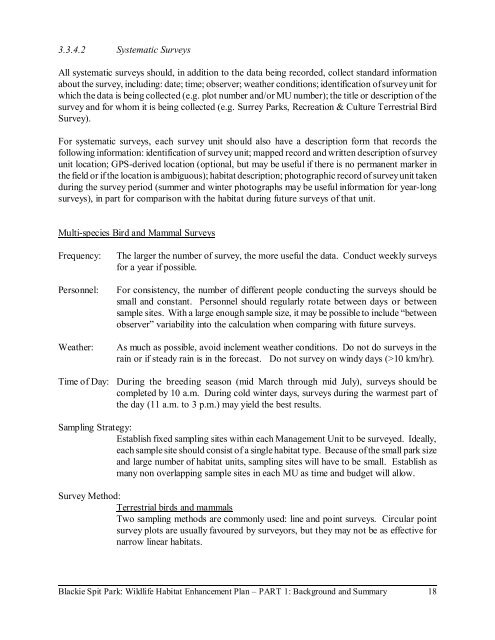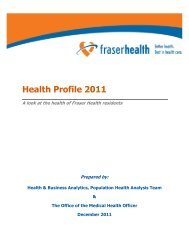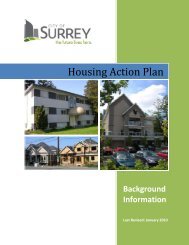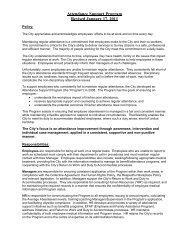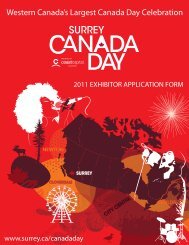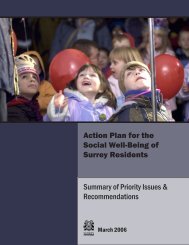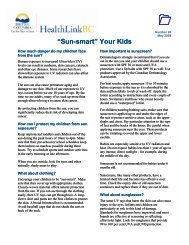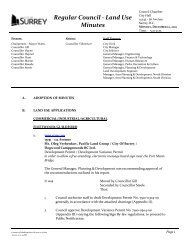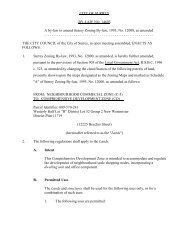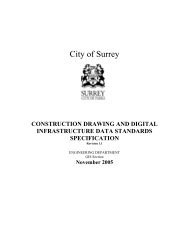Blackie Spit Park: Wildlife Habitat Enhancement Plan - City of Surrey
Blackie Spit Park: Wildlife Habitat Enhancement Plan - City of Surrey
Blackie Spit Park: Wildlife Habitat Enhancement Plan - City of Surrey
Create successful ePaper yourself
Turn your PDF publications into a flip-book with our unique Google optimized e-Paper software.
3.3.4.2 Systematic Surveys<br />
All systematic surveys should, in addition to the data being recorded, collect standard information<br />
about the survey, including: date; time; observer; weather conditions; identification <strong>of</strong> survey unit for<br />
which the data is being collected (e.g. plot number and/or MU number); the title or description <strong>of</strong> the<br />
survey and for whom it is being collected (e.g. <strong>Surrey</strong> <strong>Park</strong>s, Recreation & Culture Terrestrial Bird<br />
Survey).<br />
For systematic surveys, each survey unit should also have a description form that records the<br />
following information: identification <strong>of</strong> survey unit; mapped record and written description <strong>of</strong> survey<br />
unit location; GPS-derived location (optional, but may be useful if there is no permanent marker in<br />
the field or if the location is ambiguous); habitat description; photographic record <strong>of</strong> survey unit taken<br />
during the survey period (summer and winter photographs may be useful information for year-long<br />
surveys), in part for comparison with the habitat during future surveys <strong>of</strong> that unit.<br />
Multi-species Bird and Mammal Surveys<br />
Frequency:<br />
Personnel:<br />
Weather:<br />
Time <strong>of</strong> Day:<br />
The larger the number <strong>of</strong> survey, the more useful the data. Conduct weekly surveys<br />
for a year if possible.<br />
For consistency, the number <strong>of</strong> different people conducting the surveys should be<br />
small and constant. Personnel should regularly rotate between days or between<br />
sample sites. With a large enough sample size, it may be possible to include “between<br />
observer” variability into the calculation when comparing with future surveys.<br />
As much as possible, avoid inclement weather conditions. Do not do surveys in the<br />
rain or if steady rain is in the forecast. Do not survey on windy days (>10 km/hr).<br />
During the breeding season (mid March through mid July), surveys should be<br />
completed by 10 a.m. During cold winter days, surveys during the warmest part <strong>of</strong><br />
the day (11 a.m. to 3 p.m.) may yield the best results.<br />
Sampling Strategy:<br />
Establish fixed sampling sites within each Management Unit to be surveyed. Ideally,<br />
each sample site should consist <strong>of</strong> a single habitat type. Because <strong>of</strong> the small park size<br />
and large number <strong>of</strong> habitat units, sampling sites will have to be small. Establish as<br />
many non overlapping sample sites in each MU as time and budget will allow.<br />
Survey Method:<br />
Terrestrial birds and mammals<br />
Two sampling methods are commonly used: line and point surveys. Circular point<br />
survey plots are usually favoured by surveyors, but they may not be as effective for<br />
narrow linear habitats.<br />
<strong>Blackie</strong> <strong>Spit</strong> <strong>Park</strong>: <strong>Wildlife</strong> <strong>Habitat</strong> <strong>Enhancement</strong> <strong>Plan</strong> – PART 1: Background and Summary 18


